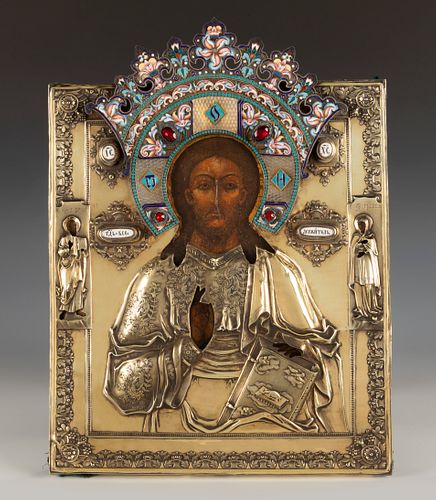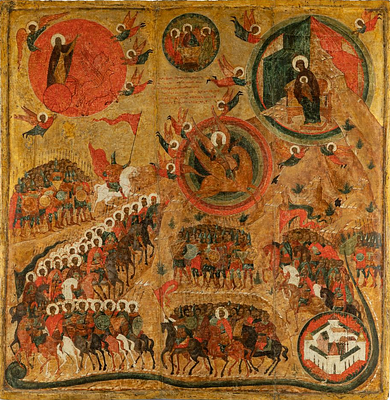Russian school, 18th-19th century. "Jesus Christ Almighty". Tempera and gold leaf on panel. Embossed silver oklad, Volga pearls, garnets and enamel, M
Lot 63
About Seller
Setdart Auction House
Carrer Aragó 346
Barcelona
Spain
Setdart Subastas was born in 2004 and is currently the first online art auction in Spain with solidity, prestige and reliability guaranteed by our more than 60,000 users. Setdart has a young, dynamic and enterprising team ready to successfully manage the purchase and sale of art works through custom...Read more
Estimate:
EUR€6,000 - EUR€8,000
$6,451.61 - $8,602.15
Absentee vs Live bid
Two ways to bid:
- Leave a max absentee bid and the platform will bid on your behalf up to your maximum bid during the live auction.
- Bid live during the auction and your bids will be submitted real-time to the auctioneer.
Bid Increments
| Price | Bid Increment |
|---|---|
| EUR€0 | EUR€10 |
| EUR€200 | EUR€25 |
| EUR€500 | EUR€50 |
| EUR€1,000 | EUR€100 |
| EUR€3,000 | EUR€200 |
| EUR€5,000 | EUR€500 |
| EUR€10,000 | EUR€1,000 |
| EUR€20,000 | EUR€2,000 |
| EUR€50,000 | EUR€5,000 |
About Auction
By Setdart Auction House
Sep 23, 2021
Set Reminder
2021-09-23 10:00:00
2021-09-23 10:00:00
America/New_York
Bidsquare
Bidsquare : RUSSIAN ICONS
https://www.bidsquare.com/auctions/setdart-auction-house/russian-icons-7431
Setdart Auction House sofia@setdart.com
Setdart Auction House sofia@setdart.com
- Lot Description
Russian school, 18th-19th century. "Jesus Christ Almighty". Tempera and gold leaf on panel. Embossed silver oklad, Volga pearls, garnets and enamel, Moscow 1829. Punctures "N.D.1829" and E.A. Measurements: 41 x 31 cm. This icon, painted in tempera on panel and protected by an embossed silver cover called an oklad, which reproduces the hidden motifs of the painting, depicts the 'Spas' or Pantocrator, the Saviour, an icon that can be seen in every Orthodox temple. It shows Christ in a robe and mantle, with long, straight hair over his shoulders and a short beard. With his right hand he blesses, and with his left hand he holds the Gospel, which may be open or closed, as here. Christ also wears a rich halo worked in silver oklad, decorated with garnets, enamels and Volga pearls, symbolising a supernatural divine light, revealed by the Saviour to his disciples on Mount Tabor. This halo or nimbus, always present in icons of the Saviour, alludes to Christ's dual nature, divine and human. The anonymous artist of the icon depicts the face of Christ as similar to a human face, and thus confesses the dogma that Christ is "fully human in his humanity". The halo above this realistic face conveys that Christ is "fully God in his divinity". Our highly decorative icon is completed by the representation of Saint John the Baptist and the Virgin Mary, who flank the figure of Christ, looking at him, with their hands raised in supplication on behalf of humanity. This representation is called Deësis (the traditional iconic conceptualisation of Christ in Majesty or Christ the Enthroned Pantocrator, flanked by the Virgin Mary and St John the Baptist) and, as in the rest of Byzantine art, is highly symbolic and expressive. As mentioned above, the icon is covered in oklad, the term given to the covering of Russian Orthodox silver icons and, in this case, with enamel, garnet cabochons and Volga stones, which covers the entire surface of the icon, leaving only the faces and hands of the figures visible. The oklad may be modern and cover an older icon, or both may belong to the same period. In the case of the auctioned icon, the oklad is detachable and bears punches 'N.D 'dash' 1829' (in Cyrillic), which correspond to the Russian master silversmith Nikolay Dubrovin, and 'E.A', which would correspond, in this case, to a lower-ranking goldsmith who worked under Dubrovin. The first punch with the initials of the master Dubrovin would be the most important, as it in turn corresponds to the master's seal of quality. Oklads have not only an aesthetic but also a practical purpose. Icons painted on wood suffer from soot from candles, humidity, temperature fluctuations and are constantly touched by parishioners. The paint also darkens, fades, cracks, crazes and rubs off. The oklad or "curling", another term used, protects the icons from damaging effects, prolonging their lifespan. As with icon painting, the materials used in making a decorative oklad have their own particular symbolism, which can tell a lot about the icon hidden underneath. For example, in the case of the auctioned icon, the main material, silver, symbolises purity and virtue, deliverance from sins and salvation of the soul. Finally, the enamel represents Christian virtues, such as humility, kindness, and love of neighbour.
- Shipping Info
-
In-house shipping available. Please inquire at admin@setdart.com.
-
- Buyer's Premium



 EUR
EUR CAD
CAD AUD
AUD GBP
GBP MXN
MXN HKD
HKD CNY
CNY MYR
MYR SEK
SEK SGD
SGD CHF
CHF THB
THB
















